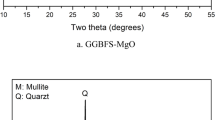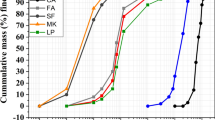Abstract
Previous studies on concrete have identified silica fume (SF) as the most effective supplementary material, whereas fly ash (FA) and slag have been identified as economical materials with long term strength potential. Development of blended cement mortar referred to as blended mortar (BM) requires similar assessment. The present study explores the application of Alccofine (AL) as supplementary material and compares its performance with conventional materials namely SF, FA and ground granulated blast furnace slag (GGBS). The mortar specimens with binder to fine-aggregates (b/f) ratio of 1:2 are prepared at water to binder (w/b) ratios of 0.4 and 0.35. The strength values and stress-strain curve for control and BM specimens are obtained at 7, 28, 56, and 90 d curing periods. The assessment based on strength activity index, k-value method and strength estimation model confirms that AL, despite lower pozzolanic activity, contributes to strength gain, due to reduced dilution effect. Assessment of stress-strain curves suggests that the effect of w/b ratio is more dominant on the elastic modulus of BM specimens than on control specimens. The observations from the study identify enhanced strength gain, improved elastic modulus and higher energy absorption as key contributions of AL making it a potential supplementary material.
Similar content being viewed by others
References
Yazıcı H, Yiğiter H, Karabulut A Ş, Baradan B. Utilization of fly ash and ground granulated blast furnace slag as an alternative silica source in reactive powder concrete. Fuel, 2008, 87(12): 2401–2407
Siddique R. Utilization (recycling) of iron and steel industry by-product (GGBS) in concrete: Strength and durability properties. Journal of Material Cycles and Waste Management, 2014, 16(3): 460–467
Siddique R. Utilization of silica fume in concrete: Review of hardened properties. Resources, Conservation and Recycling, 2011, 55(11): 923–932
Papadakis V, Tsimas S. Supplementary cementing materials in concrete Part I: Efficiency and design. Cement and Concrete Research, 2002, 32(10): 1525–1532
Papadakis V, Antiohos S, Tsimas S. Supplementary cementing materials in concrete Part II: A fundamental estimation of the efficiency factor. Cement and Concrete Research, 2002, 32(10): 1533–1538
Lane D S. Performance of slag cement in hydraulic cement concrete. Transportation Research Record: Journal of the Transportation Research Board, 2012, 2290(1): 84–88
Sisomphon K. A chemical analysis method for determining blastfurnace slag content in hardened concrete. Construction & Building Materials, 2009, 23(1): 54–61
Thomas M D A, Osborne G J, Matthewst J D, Cripwell J B. A comparison of the properties of OPC, PFA and GGBS concretes in reinforced concrete tank walls of slender section. Magazine of Concrete Research, 1990, 42(152): 127–134
Oner A, Akyuz S, Yildiz R. An experimental study on strength development of concrete containing fly ash and optimum usage of fly ash in concrete. Cement and Concrete Research, 2005, 35(6): 1165–1171
Poon C S, Kou S C, Lam L. Compressive strength, chloride diffusivity and pore structure of high performance metakaolin and silica fume concrete. Construction & Building Materials, 2006, 20(10): 858–865
Zhang M, Tam C, Leow M. Effect of water-to-cementitious materials ratio and silica fume on the autogenous shrinkage of concrete. Cement and Concrete Research, 2003, 33(10): 1687–1694
Güneyisi E, Gesoğlu M, Karaoğlu S, Mermerdaş K. Strength, permeability and shrinkage cracking of silica fume and metakaolin concretes. Construction & Building Materials, 2012, 34: 120–130
Holland R B, Kurtis K E, Kahn L F. Effect of different concrete materials on the corrosion of the embedded reinforcing steel. Corrosion of Steel in Concrete Structures, 2016: 131–147
Bhanja S, Sengupta B. Modified water-cement ratio law for silica fume concretes. Cement and Concrete Research, 2003, 33(3): 447–450
Duval R, Kadri E H. Influence of silica fume on the workability and the compressive strength of high-performance concretes. Cement and Concrete Research, 1998, 28(4): 533–547
Abdul Razak H, Wong H S. Strength estimation model for high-strength concrete incorporating metakaolin and silica fume. Cement and Concrete Research, 2005, 35(4): 688–695
Mazloom M, Ramezanianpour A A, Brooks J J. Effect of silica fume on mechanical properties of high-strength concrete. Cement and Concrete Composites, 2004, 26(4): 347–357
Poon C S, Lam L, Kou S, Wong Y L, Wong R. Rate of pozzolanic reaction of metakaolin in high-performance cement pastes. Cement and Concrete Research, 2001, 31(9): 1301–1306
Khedr S A, Abou-Zeid M N. Characteristics of silica-fume concrete. Journal of Materials in Civil Engineering, 1994, 6(3): 357–375
Chalee W, Jaturapitakkul C. Effects of W/B ratios and fly ash finenesses on chloride diffusion coefficient of concrete in marine environment. Materials and Structures, 2009, 42(4): 505–514
Ding J T, Li Z. Effects of metakaolin and silica fume on properties of concrete. ACI Materials Journal, 2002, 99: 393–398
Ghahari S, Assi L, Alsalman A, Alyamaç K. Fracture properties evaluation of cellulose nanocrystals cement paste. Materials (Basel), 2020, 13(11): 2507
Bangalore Chinnappa G, Karra R C. Experimental and statistical evaluations of strength properties of concrete with iron ore tailings as fine aggregate. Journal of Hazardous, Toxic, and Radioactive Waste, 2020, 24(1): 04019038
Alcolab (India) Pvt. Ltd. Indian Patent, 297735
Sagar B, Sivakumar M V N. Mechanical and microstructure characterization of alccofine based high strength concrete. Silicon, 2021: 1–19
Kunther W, Ferreiro S, Skibsted J. Influence of the Ca/Si ratio on the compressive strength of cementitious calcium-silicate-hydrate binders. Journal of Materials Chemistry. A, Materials for Energy and Sustainability, 2017, 5(33): 17401–17412
Parveen D, Singhal D, Junaid M T, Jindal B B, Mehta A. Mechanical and microstructural properties of fly ash based geopolymer concrete incorporating alccofine at ambient curing. Construction & Building Materials, 2018, 180: 298–307
ASTM. Standard Specification for Coal Fly Ash and Raw or Calcined Natural Pozzolan for Use. ASTM C 618-01. West Conshohocken, PA: ASTM, 2010
Smith I A. The Design of fly-ash concretes. Proceedings of the Institution of Civil Engineers, 1967, 36(4): 769–790
Garg N, Wang K. Estimating efficiency of fly ashes: An alternative definition of k values. Journal of Sustainable Cement-Based Materials, 2015, 4(1): 25–33
Zhang J, Zhao Y. The mechanical properties and microstructure of ultra-high-performance concrete containing various supplementary cementitious materials. Journal of Sustainable Cement-Based Materials, 2017, 6(4): 254–266
Ganesh Babu K, Surya Prakash P V. Efficiency of silica fume in concrete. Cement and Concrete Research, 1995, 25(6): 1273–1283
Babu K G, Nageswara Rao G S. Efficiency of fly ash in concrete. Cement and Concrete Composites, 1993, 15(4): 223–229
Razak H A, Wong H S. Strength estimation model for high-strength concrete incorporating metakaolin and silica fume. Cement and Concrete Research, 2005, 35(4): 688–695
Rao G A. Investigations on the performance of silica fume-incorporated cement pastes and mortars. Cement and Concrete Research, 2003, 33(11): 1765–1770
Megat Johari M A, Brooks J J, Kabir S, Rivard P. Influence of supplementary cementitious materials on engineering properties of high strength concrete. Construction & Building Materials, 2011, 25(5): 2639–2648
Meng W, Valipour M, Khayat K H. Optimization and performance of cost-effective ultra-high performance concrete. Materials and Structures, 2017, 50(1): 29
Shi C, Wu Z, Xiao J, Wang D, Huang Z, Fang Z. A review on ultra high performance concrete: Part I. Raw materials and mixture design. Construction & Building Materials, 2015, 101: 741–751
Siddika A, Al Mamun M A, Ferdous W, Saha A K. R. Alyousef, 3D-printed concrete: Applications, performance, and challenges. Journal of Sustainable Cement-Based Materials, 2020, 9: 127–164
Güllü H, Canakci H, Al Zangana I F. Use of cement based grout with glass powder for deep mixing. Construction & Building Materials, 2017, 137: 12–20
Joshaghani A, Moeini M A, Balapour M, Moazenian A. Effects of supplementary cementitious materials on mechanical and durability properties of high-performance non-shrinking grout (HPNSG). Journal of Sustainable Cement-Based Materials, 2018, 7(1): 38–56
IS 12269. Indian Standard Ordinary Portland Cement, 53 Grade—Specification (First Revision). New Delhi: Bureau of Indian Standards, 2013
ASTM. Standard Specification for Portland Cement. ASTM C150/C150M-20. West Conshohocken, PA: ASTM, 2020
Lothenbach B, Scrivener K, Hooton R D. Supplementary cementitious materials. Cement and Concrete Research, 2011, 41(12): 1244–1256
Garg N, Wang K. Comparing the performance of different commercial clays in fly ash-modified mortars. Journal of Sustainable Cement-Based Materials, 2012, 1(3): 111–125
IS 383. Indian Standard Coarse and Fine Aggregate for Concrete—Specification (Third Revision). New Delhi: Bureau of Indian Standards, 2016
ASTM. Standard Test Method for Sieve Analysis of Fine and Coarse Aggregates. ASTM C136/C136M-19. West Conshohocken, PA: ASTM, 2020
IS 4031 Part VI. Indian Standard Methods of Physical Tests for Hydraulic Cement. Part VI—Determination of Compressive Strength of Hydraulic Cement other than Masonry Cement (First Revision). New Delhi: Bureau of Indian Standards, 1
EN-450-1. Fly Ash For Concrete. Definition, Specifications and Conformity Criteria. London: British Standards Institute, 2005
Schiessl P, Hardtl R. Efficiency of Fly Ash in Concrete Evaluation of ibac Test Results. Technical Report of Institut für Bauforschung, 1991
Pekmezci B Y, Akyüz S. Optimum usage of a natural pozzolan for the maximum compressive strength of concrete. Cement and Concrete Research, 2004, 34(12): 2175–2179
Ganesh Babu K, Sree Rama Kumar V. Efficiency of GGBS in concrete. Cement and Concrete Research, 2000, 30(7): 1031–1036
Gruyaert E, Maes M, de Belie N. Performance of BFS concrete: k-value concept versus equivalent performance concept. Construction & Building Materials, 2013, 47: 441–455
IS 4031 Part IV. Indian Standard Methods of Physical Tests for Hydraulic Cement. Part IV—Determination of Consistency of Standard Cement Paste. New Delhi: Bureau of Indian Standards, 1
IS 4031 Part V. Indian Standard Methods of Physical Tests for Hydraulic Cement. Part V—Determination of Initial and Final Setting Times. New Delhi: Bureau of Indian Standards, 1
ASTM. Time of Setting of Hydraulic Cement By Vicat Needle. ASTM C-191-08. West Conshohocken, PA: ASTM, 2008
Brooks J J, Johari M A M, Mazloom M. Effect of admixtures on the setting times of high-strength concrete. Cement and Concrete Composites, 2003, 25: 161–164
Acknowledgements
Authors are thankful to Counto Microfine Products Private Limited for supplying the Alccofine and Mr. Mohammed Tabish Anwer, Senior Concrete Technologist, Fosroc India Private Limited for providing chemical admixtures used in the study.
Author information
Authors and Affiliations
Corresponding author
Electronic supplementary material
Rights and permissions
About this article
Cite this article
Jayswal, S.D., Mungule, M. Performance assessment of Alccofine with silica fume, fly ash and slag for development of high strength mortar. Front. Struct. Civ. Eng. 16, 576–588 (2022). https://doi.org/10.1007/s11709-022-0826-0
Received:
Accepted:
Published:
Issue Date:
DOI: https://doi.org/10.1007/s11709-022-0826-0




